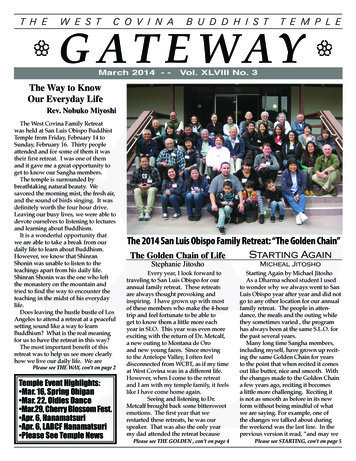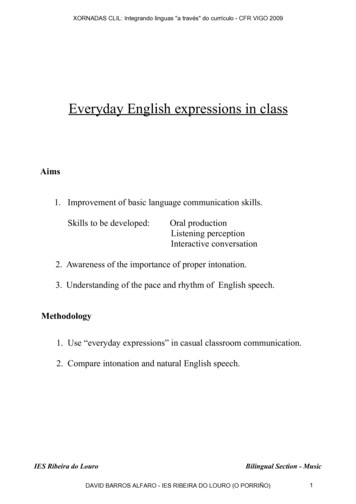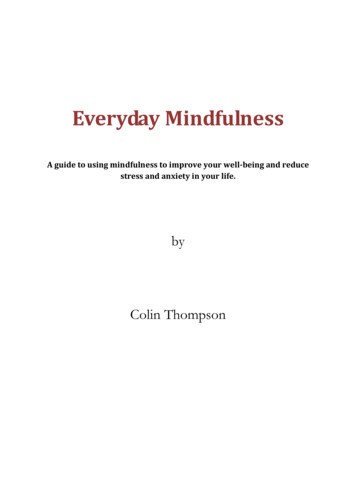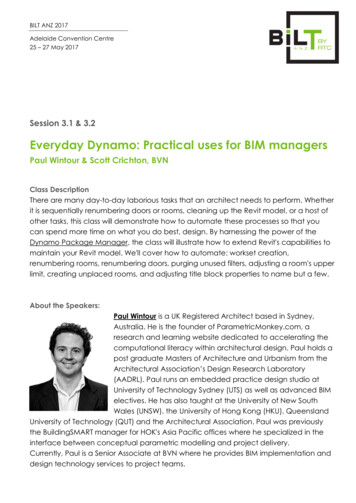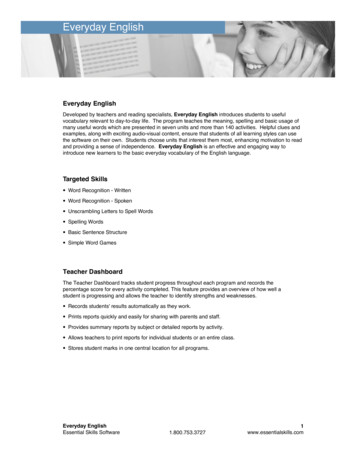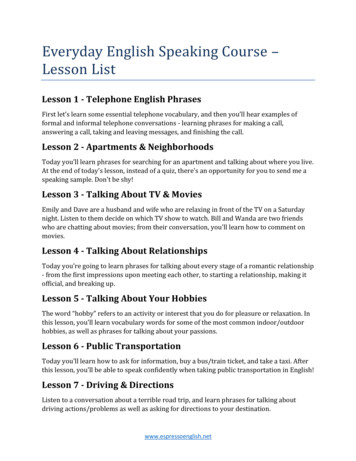
Transcription
11An Overviewof EverydayCommunicationIf you think there is anything important in your life that does not involve communication, leaf idly through this book and see if it makes you challenge your firstthought. It will take only a couple of minutes, and then you can put the book backon the shelf. However, we do not think you will be able to come up with very manyactivities in life that are not improved by communication and that would not be madebetter by your ability to understand communication more thoroughly. We wrote thisbook partly because we believe that everyone needs to know something about communication. Especially if you are a student, Communication in Everyday Life will help youimprove your life through understanding communication, whether you are headed offto become a dental hygienist, a researcher, a preacher, a businessperson, a nurse, a physician, a member of a sales force, a parent, or just somebody’s good friend.We are passionate about the study of communication because it has so many obvioususes and influences in everyday life, and we believe very strongly that you too can benefit from knowing more about how communication works. We have never met anyonewho did not want to understand more about his or her everyday life and, in particular,about his or her relationships. We have tried to bind together these interests by writingthis book, which answers questions about how communication and relationships hangtogether and connect with other parts of life, such as listening, culture, gender, media,giving presentations, or merely being you. We cover all of this with a particular themein mind—the way you carry out your everyday life through your relationships withother people—and how the above are relevant to our theme.The phrase relationships with other people draws your attention not only tohow your relationships work and can be improved but also to how they affect you1
2Chapter 1 An Overview of Everyday Communicationduring the course of other activities that happen in your life. Your relationshipwith someone affects your ability to persuade that person to take your healthadvice, for example, or the media that you use can become topics of discussionbetween acquaintances. Cell phones and Facebook are forms of communicationthat have become relational tools in everyday life, especially if you are in long-distancerelationships. So, in this book, we deal not just with the creation of relationships butwith the way relationships flow into many other daily experiences as effects not onlyon those experiences themselves but also on everyday life communication.We sincerely believe that your daily life as a student, friend, romantic partner, colleague, and family member can be improved through the principles of communicationtheory. One of our purposes is to help you understand your daily life by making youmore aware of how everyday life works through communication. We believe that allstudents desire to see, recognize, and understand their many instances of daily contactwith communication research and theory. Another purpose is to develop your studiesby encouraging more eager and independent thinking about research into such topics as conflict, relationship development, gender, culture, technology, and business andprofessional speaking.Whatever your purpose in reading this book, and whatever your ultimate goalin life, we hope that it will enrich your experience, sharpen your abilities to observeand analyze communication activity, and make your life a little bit more interestingbecause you can understand the processes going on around you. So take us up on ourchallenge. Thumb through the contents and look at a few of the pictures to see if younow “get” what we think is important about communication and why you need tolearn about it.?Focus Questions What is communication, and how does it work in your everyday life? How does communication create worlds of meaning? How do the assumptions in a culture affect communication? What are the properties of communication? What does it mean to say that communication is both representational andpresentational, and why is the difference important? What is a “frame,” and how is communication framed? What is a working definition of communication for this book?How This Book Is Structured toHelp Your LearningBecause we are convinced of the importance of the topic and because we are passionate about helping people learn about it, we have used some special features designed to
Chapter 1 An Overview of Everyday Communicationmake it particularly interesting and relevant to you. First of all, the tone of this book issomewhat different from other textbooks you may have come across. We have deliberately adopted an informal and conversational tone in our writing, and we even throw ina few jokes. We are not attempting to be hip or cool: Trust us; we are far from either, somuch so that we are not even sure if the words hip and cool are used anymore. Instead,we use a conversational voice because we believe that it makes this book more engagingto read. Plus, we genuinely like and have a good time talking about this material, so wewant to share our enthusiasm in a way that we hope is infectious. We have become usedto seeing the significance of communication as if it speaks for itself, but we realize thatnot everybody else takes that view. Because we are also deeply committed to the importance of studying communication, we want to discuss it all in such a way that is clear,understandable, and applicable to your life. We hope that this will make it as exciting toyou as it is to us.Everything that appears in this book—even every picture—does so for a reason,and that reason centers on increasing your understanding, your application, and evenyour enjoyment of the material. For example, the pictures do not have standard captions, but each asks a question that you can answer for yourself, although we providepossible answers at the end of each chapter. The pictures are here not just to make thebook look pretty, but they serve the purpose of teaching you something and makingyou think for yourself.Instead of beginning each chapter with questions to focus on before you know whatthe chapter is about, our Focus Questions follow an opening narrative for each chapter. They are so positioned because we want to ensure that you read them after you haveseen the basic issues with which the chapter deals. We personally skipped them whenwe were in school: They appeared at the very beginning of the chapter, and we did notyet know what they were about. We strongly encourage you to read them. Because theycome after the narrative that sets up the questions in each chapter, they will guide youthrough the chapter and provide you with insight as to what you should focus on as youread. Because they are important, we will also revisit and answer them at the end ofeach chapter so that you can see if your answers match ours. In fact, we do this insteadof summarizing the chapter in the conventional way. The end of every chapter is therefore directly connected to the beginning.Although we wanted to limit the number appearing in each chapter, boxes can havea great deal of value for your learning. Each chapter includes the following four types ofboxes: (1) Make Your Case, (2) Strategic Communication, (3) Listen In On Your Life,and (4) Contrarian Challenge. Make Your Case boxes provide you with opportunitiesto develop your own positions or to perform an exercise about the material that mightbe used during class discussion. In the language chapter, for example, you are askedto find out the secret languages that you and your friends speak without realizing it.Strategic Communication boxes help you integrate the material into your life wheninfluencing others. For instance, the technology chapter asks you to consider how thepurpose of a message and the technological preferences of the person you are contactingwill determine the appropriateness of face-to-face, telephone, or computer-mediatedinteraction. Listen In On Your Life boxes ask you to consider the material in relation toyour own life and lived experiences. We want you to start recognizing communicationin your life and how the discussed material applies. For example, the listening chapterasks you to consider friends, family, classmates, or coworkers you would label as good3
4Chapter 1 An Overview of Everyday Communicationand bad listeners. You are then asked to analyze what behaviors led to these evaluations and to determine measures to enhance the listening skills of others. These exercises, therefore, will also serve to further your understanding and comprehension of thematerial. Finally, Contrarian Challenge boxes invite you to think more carefully aboutwhat you have read and see if we have persuaded you or if you can see another side towhat we have written. For example, although this chapter will present communicationin a logical way, as do other textbooks, we invite you to answer the challenge of whethercommunication in everyday life is actually quite messy and disorganized and much lessclear and clean than the theories present.Also included in each chapter are margin notes, which provide additional information about the material or open-ended questions to ponder as you study it. Accordingly,some margin notes provide unique information, such as when the first “smiley face”emoticon was sent, who invented the Internet, or what percentage of people believethat they are shy enough to need treatment. Other margin notes urge you to reflect onthe material by posing questions, such as whether or not families would be considered“groups.”The very end of each chapter includes features to further enhance your mastery andcomprehension of the material. Once again, we thought very carefully about what toinclude here. We did not want questions that ask you to merely memorize and repeatwhat you read in this book; rather we wanted those that ask you to think about it outsideof class as you carry out the rest of your life. We wanted to include features that ask youto go beyond each chapter’s contents and engage in higher levels of thinking.Accordingly, each chapter also includes the following features: (a) Ethical Issues,(b) Media Links, and (c) Questions to Ask Your Friends. Ethical Issues urge you tocontemplate and develop a position regarding ethical quandaries that arise in communication. For example, the technology chapter asks you to consider whether employersshould use material on social networking sites, such as Facebook, when making hiringdecisions, and the relationships chapter asks if it is ever ethical to have two romanticrelationships going on at the same time and why (or why not). Media Links ask you todraw from media in order to further explore the issues discussed in each chapter. Youare asked to watch a TV newscast and discover ways in which the newscasters establisha relationship with the audience, for example, and to read a newspaper article lookingfor examples of logical fallacies. The relationships chapter invites you to examine theSunday newspaper section of marriages, engagements, and commitment ceremoniesfor similarities in attractiveness. Believe it or not, romantic partners often look alike!Finally, Questions to Ask Your Friends provide you with questions to ask your friendsin order to further increase your awareness of the material and integrate it into yourlife. In the culture and society chapter, for example, you are urged to ask your friendsabout favorite children’s stories and connect themes to cultural ideals. It may initiallyseem strange to drag your friends into your own learning, but in fact, just as in everydaylife itself, you will learn from them, and you will be teaching them a thing or two aswell. Plus, this activity will help underscore the significance of relationships in your life.As with the boxes, we are serious about having you try out these instructional tools toimprove your study of the material.A Student Study Site is also available to improve your study of the material. Itincludes electronic flashcards to check your knowledge of key terms and concepts, studyquizzes, Internet activities and resources, links to video and audio clips, and a link
Chapter 1 An Overview of Everyday Communicationto the Facebook group we’ve created for the book. You can access the site for free atwww.sagepub.com/ciel.Ultimately, we want to invite students—you and others you know—into the conversation about the issues we present as basics of communication. As part of that, we are tryingto stretch your capacity to think about a problem and work through it with us, leaving youwith a greater sense of having mastered the material by thinking through it for yourself,under guidance. Because we want to increase the discussion of communication generally,we continually mention everyday issues so that you can talk about them with your friendsand become more helpful to them too. You should be able to reflect on your friends’ andyour own lives from time to time and apply to them what you have been reading abouthere. “You know, funny you should say that because I’ve just been reading about that exactsame thing, and what the book said was . . .” Which leads us neatly into the first issue toconsider: the way communication is so intricately tied up with relationships.Communication and RelationshipsCommunication and relationships are intertwined processes. Not merely speakinginto the air, communication is speaking into relationships, whether you are speaking toyour best friend about something personal, signaling your membership with fellowcitizens by honoring the flag, or presenting a talk to an audience of complete strangers. Furthermore, “communication” is not simply messages sent from one person toanother; communication does something: It causes a result, creates an atmosphere,manages an identity, and, for example, reveals your age, gender, race, or culture. That is,an
Communication in Everyday Life. will help you improve your life through understanding communication, whether you are headed off to become a dental hygienist, a researcher, a preacher, a businessperson, a nurse, a phy - sician, a member of a sales force, a parent, or just somebody’s good friend. We are passionate about the study of communication because it has so many obvious . uses and .




